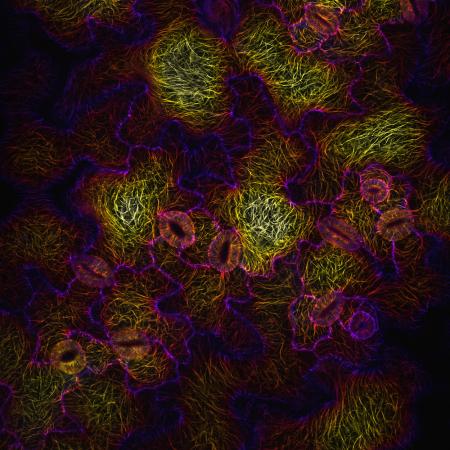For Cells, Internal Stress Leads to Unique Shapes

Credit: Arun Sampathkumar/Caltech
Interested in how these cells individually take on their own unique forms, Caltech biologist Elliot Meyerowitz, postdoctoral scholar Arun Sampathkumar, and colleagues sought to pinpoint the shape-controlling factors in pavement cells, which are puzzle-piece-shaped epithelial cells found on the leaves of flowering plants.
They found that these unusual shapes were the cell's response to mechanical stress on the microtubule cytoskeleton—protein tubes that act as a scaffolding inside the cells. These microtubules guide oriented deposition of cell-wall components, thus providing structural support.
The researchers studied this supportive microtubule arrangement in the tissue of pavement cells from the first leaves—or cotyledons—of a young Arabidopsis thaliana plant (right).
By fluorescently marking the cells' microtubules (yellow, top surface of cell; purple, bottom surface of cell), the researchers could image the cell's structural arrangement—and watch how this arrangement changed over time.
They could also watch the microtubule modifications that occurred due to changes in the mechanical forces experienced by the cells.
Microtubules strengthen a cell's structure by lining up in the direction of stress or pressure experienced by the cell and guiding the deposition of new cell-wall material, providing a supportive scaffold for the cell's shape.
However, Meyerowitz and colleagues found that this internal stress is also influenced by the cell's shape. The result is a feedback loop: the cell's shape influences the microtubule arrangement; this arrangement, in turn, affects the cell's shape, which modulates the microtubules, and so on.
Therefore, the unusual shape of the pavement cell represents a state of balance—an individual cell's tug-of-war to maintain structural integrity while also dynamically responding to the pushes and pulls of mechanical stress.
The results of the study were published in the journal eLife on April 16. Elliot Meyerowitz is George W. Beadle Professor of Biology and an investigator with the Howard Hughes Medical Institute.
Written by Jessica Stoller-Conrad
Contact:
Caltech Media Relations
Media Contact
More Information:
http://www.caltech.eduAll latest news from the category: Life Sciences and Chemistry
Articles and reports from the Life Sciences and chemistry area deal with applied and basic research into modern biology, chemistry and human medicine.
Valuable information can be found on a range of life sciences fields including bacteriology, biochemistry, bionics, bioinformatics, biophysics, biotechnology, genetics, geobotany, human biology, marine biology, microbiology, molecular biology, cellular biology, zoology, bioinorganic chemistry, microchemistry and environmental chemistry.
Newest articles

High-energy-density aqueous battery based on halogen multi-electron transfer
Traditional non-aqueous lithium-ion batteries have a high energy density, but their safety is compromised due to the flammable organic electrolytes they utilize. Aqueous batteries use water as the solvent for…

First-ever combined heart pump and pig kidney transplant
…gives new hope to patient with terminal illness. Surgeons at NYU Langone Health performed the first-ever combined mechanical heart pump and gene-edited pig kidney transplant surgery in a 54-year-old woman…

Biophysics: Testing how well biomarkers work
LMU researchers have developed a method to determine how reliably target proteins can be labeled using super-resolution fluorescence microscopy. Modern microscopy techniques make it possible to examine the inner workings…





















